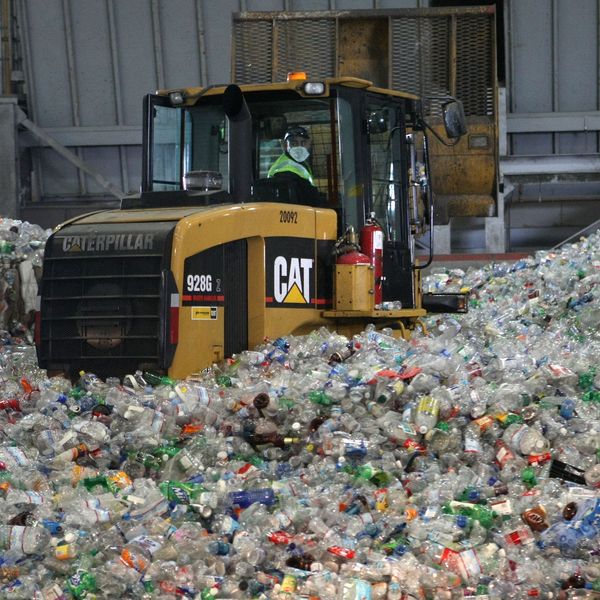Industrial Pollution Brings Suffering to 125 Million People: Report
Increasing demand of 'developed' countries at root of problem
One hundred and twenty-five million people around the world suffer from serious health problems that stem from industrial pollution -- a public health crisis on par with malaria or tuberculosis (TB) -- according to a report released this week by the Blacksmith Institute.
The report documents sickness in 49 low and middle income countries with large industrial sectors, including toxin heavy mining sites, tanneries, chemical factories and toxic waste processing sites, and traces the most common industrial pollutants - lead, mercury, chromium, radionuclides and pesticides - in the air, water and soil of the, so called, developing countries.
Those most often sickened by the pollution are children.
The report, while revealing unprecedented amounts of pollution induced sickness, is still an "extremely conservative estimate" according to the report.
"We've investigated 2,600 toxic sites in the last four years, [but] we know there are far more," said Bret Ericson of the Blacksmith Institute.
According to the study, The World's Worst Pollution Problems (pdf), such toxic sites within the countries documented are commonly within a close vicinity to residential areas, a leading factor in the alarming numbers.
"We see a lot of disease when we go into these communities," said Ericson. "But we were surprised the health burden was so high - as much as malaria."
Stephan Robinson, of partner institution Green Cross Switzerland, clarified that a leading factor in the rise of dangerous and unregulated toxic sites in these countries is industrial globalization, especially international mining and resource extraction, and global consumer demand.
"Much of this industrial activity is to serve our needs in the developed world," said Robinson.
"Life-threatening pollution will likely increase as the global economy exerts an ever-increasing pressure on industry to meet growing demands. The damage will be greatest in many low and middle-income countries, where industrial pollution prevention regulations and measures have not kept pace," stated Richard Fuller, President, Blacksmith Institute.
An Urgent Message From Our Co-Founder
Dear Common Dreams reader, The U.S. is on a fast track to authoritarianism like nothing I've ever seen. Meanwhile, corporate news outlets are utterly capitulating to Trump, twisting their coverage to avoid drawing his ire while lining up to stuff cash in his pockets. That's why I believe that Common Dreams is doing the best and most consequential reporting that we've ever done. Our small but mighty team is a progressive reporting powerhouse, covering the news every day that the corporate media never will. Our mission has always been simple: To inform. To inspire. And to ignite change for the common good. Now here's the key piece that I want all our readers to understand: None of this would be possible without your financial support. That's not just some fundraising cliche. It's the absolute and literal truth. We don't accept corporate advertising and never will. We don't have a paywall because we don't think people should be blocked from critical news based on their ability to pay. Everything we do is funded by the donations of readers like you. Will you donate now to help power the nonprofit, independent reporting of Common Dreams? Thank you for being a vital member of our community. Together, we can keep independent journalism alive when it’s needed most. - Craig Brown, Co-founder |
One hundred and twenty-five million people around the world suffer from serious health problems that stem from industrial pollution -- a public health crisis on par with malaria or tuberculosis (TB) -- according to a report released this week by the Blacksmith Institute.
The report documents sickness in 49 low and middle income countries with large industrial sectors, including toxin heavy mining sites, tanneries, chemical factories and toxic waste processing sites, and traces the most common industrial pollutants - lead, mercury, chromium, radionuclides and pesticides - in the air, water and soil of the, so called, developing countries.
Those most often sickened by the pollution are children.
The report, while revealing unprecedented amounts of pollution induced sickness, is still an "extremely conservative estimate" according to the report.
"We've investigated 2,600 toxic sites in the last four years, [but] we know there are far more," said Bret Ericson of the Blacksmith Institute.
According to the study, The World's Worst Pollution Problems (pdf), such toxic sites within the countries documented are commonly within a close vicinity to residential areas, a leading factor in the alarming numbers.
"We see a lot of disease when we go into these communities," said Ericson. "But we were surprised the health burden was so high - as much as malaria."
Stephan Robinson, of partner institution Green Cross Switzerland, clarified that a leading factor in the rise of dangerous and unregulated toxic sites in these countries is industrial globalization, especially international mining and resource extraction, and global consumer demand.
"Much of this industrial activity is to serve our needs in the developed world," said Robinson.
"Life-threatening pollution will likely increase as the global economy exerts an ever-increasing pressure on industry to meet growing demands. The damage will be greatest in many low and middle-income countries, where industrial pollution prevention regulations and measures have not kept pace," stated Richard Fuller, President, Blacksmith Institute.
One hundred and twenty-five million people around the world suffer from serious health problems that stem from industrial pollution -- a public health crisis on par with malaria or tuberculosis (TB) -- according to a report released this week by the Blacksmith Institute.
The report documents sickness in 49 low and middle income countries with large industrial sectors, including toxin heavy mining sites, tanneries, chemical factories and toxic waste processing sites, and traces the most common industrial pollutants - lead, mercury, chromium, radionuclides and pesticides - in the air, water and soil of the, so called, developing countries.
Those most often sickened by the pollution are children.
The report, while revealing unprecedented amounts of pollution induced sickness, is still an "extremely conservative estimate" according to the report.
"We've investigated 2,600 toxic sites in the last four years, [but] we know there are far more," said Bret Ericson of the Blacksmith Institute.
According to the study, The World's Worst Pollution Problems (pdf), such toxic sites within the countries documented are commonly within a close vicinity to residential areas, a leading factor in the alarming numbers.
"We see a lot of disease when we go into these communities," said Ericson. "But we were surprised the health burden was so high - as much as malaria."
Stephan Robinson, of partner institution Green Cross Switzerland, clarified that a leading factor in the rise of dangerous and unregulated toxic sites in these countries is industrial globalization, especially international mining and resource extraction, and global consumer demand.
"Much of this industrial activity is to serve our needs in the developed world," said Robinson.
"Life-threatening pollution will likely increase as the global economy exerts an ever-increasing pressure on industry to meet growing demands. The damage will be greatest in many low and middle-income countries, where industrial pollution prevention regulations and measures have not kept pace," stated Richard Fuller, President, Blacksmith Institute.

